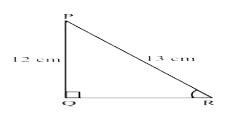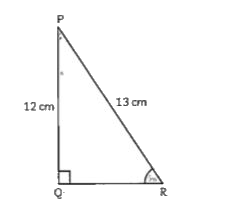In △PQR, right angled at Q, tanP−cotR is:
1
0
−1
2
To solve the problem, we need to find the value of tanP−cotR in the right triangle △PQR where the right angle is at Q.
1. Identify the Angles and Sides:
In triangle PQR:
- Angle P is at vertex P.
- Angle Q is at vertex Q (right angle).
- Angle R is at vertex R.
2. Understand the Definitions:
- tanP is defined as the ratio of the opposite side to the adjacent side with respect to angle P.
- cotR is defined as the ratio of the adjacent side to the opposite side with respect to angle R.
3. Express tanP:
- In triangle PQR, the side opposite to angle P is QR and the side adjacent to angle P is PQ.
- Therefore, tanP=QRPQ.
4. Express cotR:
- In triangle PQR, the side opposite to angle R is PQ and the side adjacent to angle R is QR.
- Therefore, cotR=PQQR.
5. Substitute the Values:
Now we can substitute these expressions into the equation:
tanP−cotR=QRPQ−PQQR
6. Find a Common Denominator:
The common denominator for the two fractions is PQ⋅QR:
tanP−cotR=QR⋅QR−PQ⋅PQPQ⋅QR=QR2−PQ2PQ⋅QR
7. Evaluate the Expression:
Since QR2−PQ2 does not simplify to zero in general, we need to consider the specific case of right triangles. However, in this case, we can observe that:
- In a right triangle, QR and PQ are related through the Pythagorean theorem, but we are specifically looking for tanP−cotR.
8. Conclusion:
Since both tanP and cotR are reciprocals of each other in the right triangle, we find that:
tanP−cotR=0
Final Answer:
tanP−cotR=0
In triangle PQR:
- Angle P is at vertex P.
- Angle Q is at vertex Q (right angle).
- Angle R is at vertex R.
- tanP is defined as the ratio of the opposite side to the adjacent side with respect to angle P.
- cotR is defined as the ratio of the adjacent side to the opposite side with respect to angle R.
- In triangle PQR, the side opposite to angle P is QR and the side adjacent to angle P is PQ.
- Therefore, tanP=QRPQ.
- In triangle PQR, the side opposite to angle R is PQ and the side adjacent to angle R is QR.
- Therefore, cotR=PQQR.
Now we can substitute these expressions into the equation:
tanP−cotR=QRPQ−PQQR
The common denominator for the two fractions is PQ⋅QR:
tanP−cotR=QR⋅QR−PQ⋅PQPQ⋅QR=QR2−PQ2PQ⋅QR
Since QR2−PQ2 does not simplify to zero in general, we need to consider the specific case of right triangles. However, in this case, we can observe that:
- In a right triangle, QR and PQ are related through the Pythagorean theorem, but we are specifically looking for tanP−cotR.
Since both tanP and cotR are reciprocals of each other in the right triangle, we find that:
tanP−cotR=0
tanP−cotR=0
Topper's Solved these Questions
- SAMPLE PAPER 10BOOK - EDUCART PUBLICATIONCHAPTER - SAMPLE PAPER 10EXERCISE - SECTION-B
20 Videos
- SAMPLE PAPER 1BOOK - EDUCART PUBLICATIONCHAPTER - SAMPLE PAPER 1EXERCISE - Section -C
10 Videos
- SAMPLE PAPER 10 (SELF-ASSESSMENT)BOOK - EDUCART PUBLICATIONCHAPTER - SAMPLE PAPER 10 (SELF-ASSESSMENT)EXERCISE - Section-C (Case Study Based Questions)
10 Videos
Similar Questions
Knowledge Check
If, in a △PQR, right angled at R,
tan(P2)andtan(Q2) are the roots of the equation ax2+bx+c=0,a≠0, thenAa+b=cBb+c=aCc+a=bDb=c
Find tan P – cot R

View SolutionIn △PQR, right angled at Q, the value of tan2P−sec2P is:
View SolutionIn △PQR, right angled at Q, PQ=105 and QR=208, the value of tanR is:
View SolutionIn △PQR, right angled at Q, the value of sin2P+cos2P is:
View SolutionIn △PQR, right angled at Q, PR+QR=30cm and PQ=10cm then the value of angle P is
View SolutionIn △PQR , right angled at Q, PQ=4cm and RQ=3cm . Find the values of sinP , sinR , secP and secR .
View SolutionIn △PQR , right-angled at Q, PQ=3cm and PR=6cm . Determine ∠P and ∠R .
View Solution

